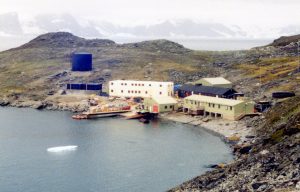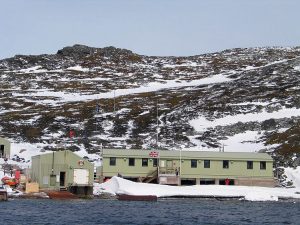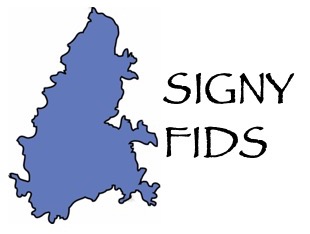During this decade a significant amount of marine research became established in Marguerite Bay, operating out of Rothera Station. There was also an increasing amount of terrestrial research being undertaken at remote Peninsula field sites and Marguerite Bayislands, accessed by Twin Otter flights out of Rothera. Financial constraints required a re-assessment of the BAS research stations and there was pressure to focus more activities at Rothera, Halley and on ocean research, areas where much of the post-Falklands funding from government had been directed. This resulted in Faraday Station (Argentine Islands) being handed over to the Ukrainian Antarctic Research Programme at this time.
Signy was also under consideration for closure at the time but it’s political significance as a British presence in the South Orkney Islands meant it had to be kept active. The financial compromise was that it was converted from a wintering station to a much smaller summer-only facility without the diving capability that had been such a feature of wintering Signy. The first half of the decade continued to see significant research activity but inevitably much of 1994 and 1995 was taken up with the dismantling of Sorlle House and removal of equipment to allow construction of the new station. 
The newly established summer-only Signy Station in 1997 with most of the old wintering structures still in place. The new bunded fuel tank is clearly visible left of the Plastic Palace but still lacking the building that would be erected over it.
Early days of the summer-only Signy Station (1995-2000)
Cynan Ellis-Evans
The BAS budget increased dramatically through the 80s after the Falklands conflict but the funding was mainly provided for large capital projects (a new ship (James Clark Ross), new planes, expanded stations). Unfortunately it was not supported by a comparable uplift in recurrent funding year-on-year to operate these capital investments effectively. By the end of the 80s we were back into financial cuts to balance the books and by the 90s both Faraday and Signy came under scrutiny now that the BAS research focus was seen as Halley, Rothera and our offshore marine programmes. Bird Island’s unique credentials ensured it dodged the bullet but Faraday was transferred to the Ukrainian Antarctic Programme in 1996 and renamed Vernadsky. When we visited Vernadsky in 2015 the Ukrainians had kept all the BAS base photographs on the walls and maintained the legendary Faraday bar so the station still has much of the feel of an old Fid base to complement what is undeniably one of the most photogenic backdrops in Antarctica.
Signy Station’s importance for the UK’s British Antarctic Territories claim meant that the Foreign Office would not countenance its closure. Instead it was decided to rebuild it as a summer-only operation on the site of the existing station. It would use the footprint of the two-storied Sørlle House, the large building that had replaced the old boatshed and the two small store buildings of the 1970s station in the 1980’s, as the location for a new single storey science and accommodation block – also to be called Sorlle House. It followed the form of new buildings at Rothera and Bird Island with metal-clad thick insulated wood-panelled walls and triple-glazed windows. The new laboratories were designed to modern standards and the pit rooms were a major step up from the very basic rooms we had in the Plastic Palace.
A properly bunded fuel tank housed in its own shed was built to one side of the Plastic Palace site. The Genny Shed established in the mid-1970s became the main store and housed new walk-in food freezers. The Boatshed, also built in the 1970’s, was reconfigured as the new generator shed and its workshop housed a reverse osmosis plant to generate fresh water from seawater. A new satellite communication dome was installed up beyond the old Fuel Tank.

The current Signy Station after the old station buildings had been removed by 2003.
The oldest buildings (Tønsberg, the Plastic Palace) as well as the old Fuel Tank and the water reservoir were to be removed, though this did not finally happen until 2003 as there were substantial environmental issues associated with the clear-up. For old Fids visiting Signy during these early years of the new station, it was depressing to see the old buildings, that had been home to us for up to two years at a time, now largely gutted, rapidly deteriorating and lifeless, used only as temporary storage areas. The demolition of the original Sorlle building was particularly sad as it marked the end of the legendary Signy Biostore which had accumulated an enormous variety of equipment over the decades as it regularly relocated around the base. Any number of research projects were rescued by finding some obscure part on one of the shelves or seeing some item that inspired the solution to a problem not foreseen back in UK.
The new station brought new ways of operating. At first relief, a technical team went ashore to get the station up and running – notably the generator and reverse osmosis plant running, and the central heating boilers started, after refilling the radiator plumbing drained over winter. The first opening took 2-3 days as I recall but it became much slicker over time. At the end of the season the station had to be put into winter mode over several days and sealed up until the next spring so research had to be run down before this could start.
When the winter metal shutters came off the windows, the station came to life and was a very comfortable building on the whole, if rather soulless when compared to the old buildings. I personally missed the twin Aga cookers (installed in 1976) of the Plastic Palace which ran off AVTUR. To my mind they were a delight to cook on though some of the professional chefs had a rather different opinion of them. The Signy Agas did have a habit of switching off if a Fid accidentally kicked the control boxes whilst wandering around the kitchen and this invariably led to one very unhappy Cook later in the day! The replacement range for the new station was necessarily a much more compact electric affair which did the job but by comparison was rather pedestrian in terms of cooking enjoyment.
There were some technical problems with the station at the outset. The BAS computers left over winter took several days to “thaw out” and to come to life. More significantly, the central heating boilers (since replaced) had been seriously over-specified and to keep room temperatures bearable had to be run at virtually tick-over settings. This caused ongoing problems for their routine maintenance. We also had issues with the reverse osmosis (RO) plant at times. The seawater intake would get blocked during storms and the toilet waste pipe which also ran out into Factory Cove sometimes ended up moving too close to the RO intake which rapidly degraded water quality! The DEM would be seen at such times trying to separate the intake from the outlet without flooding his chest waders as he waded in the Cove shallows.
The living accommodation comprised four bedrooms to accommodate 8 personnel, showers, a small store room, a medical room, kitchen and a living area (but no bar) with folding tables and chairs to save space. The original plans had been for a slightly larger building to accommodate 12 people in six bedrooms but this was reduced late in the planning, which saved money but impacted the science, travel options and search and rescue capabilities. As with the old winter base, more people could be accommodated for short periods, in locations such as the medical room, so the summer maximum could rise to 12. On the work side there was an entrance hall where all the outdoor gear was stored and then a BC’s office/radio shack, a well-appointed scientific instrumentation laboratory and a general laboratory for researchers. A new satellite communication system meant that we had much improved links to Cambridge.
The range of science changed with the move and the greater emphasis by BAS on research further South. Terrestrial and marine research had by now moved entirely to Rothera and there was no longer a diving capability. The workboat Pomona was taken out and with boating restrictions severely limiting the use of the inflatables these were also soon removed. A freshwater programme continued into the early 2000’s with a field technician and a scientist each year using more automated field instrumentation to get around the lack of wintering researchers. For example, we were doing molecular biology, normally undertaken only in high spec. laboratories, we were using automated water chemistry analyzers in a dedicated chemistry lab and deploying novel computer-controlled systems for measuring stream flow rates as well as in situ wind/solar battery-powered micro-meteorological stations at various remote locations.
The year-round long-term lakes monitoring programme originally started by Barry Heywood was clearly impractical in the limited season and had to be largely abandoned in 1996. However, the data already collected generated a final synthesis paper referenced by the Intergovernmental Panel on Climate Change (IPCC) as clear evidence of climate change influencing Antarctic terrestrial and freshwater ecosystems.
Birds and seals research was maintained at Signy through a field scientist, though the focus was now primarily on penguin studies similar to those carried out at Bird Island which have continued successfully up to the present. I recall that the freshwater technician had initially encountered highly unstable baselines that were disrupting our ultra-sensitive water chemistry analyses. This was quickly tracked down to the very smelly penguin stomach contents being examined by the Birds and Seals scientist, Amanda Lynnes, in the neighbouring lab. We had to develop a timetable with Amanda to minimise an overlap in our respective analyses.
The ambition for the summer-only station was to replace the BAS dominated science with more summer scientists from both UK and overseas institutions and this has proved quite successful over time. However, with the exception of the impressive long term penguin and seal studies, research is now essentially confined to short-term projects. The long-term monitoring and structured ecosystem studies across terrestrial, freshwater and marine environments for which Signy was internationally long renowned have ended.
With no full-time cook or boatman and the mechanic covering the engineering and electrical work, the summer station had to be run more like Bird Island. Everyone contributed to a reduced night watch. In practice this meant being last to bed after doing a check of the station buildings and getting up early for further station checks, bread-making and setting up for breakfast. In these early days of the summer-only station the BC (at that time Martin Davey) was also a part-time boatman who operated a “Mirounga Ferry” across Borge Bay to Miroungs Flats in support of the lake research and monitoring visits to the North Point penguin colonies. Though this ferry could be rather inconvenient for the BC with many other jobs to do it was incredibly helpful and time saving for the researchers. However, it was in time eventually cancelled due to the removal of the last boats from Signy.
Boating restrictions prevented trips beyond North Point so work on the west coast required back-packing over the island and the positioning of heavy field equipment required assistance from the BAS ships. Deterioration of the Orwell Glacier eventually led to a ban on crossing it and the low station numbers meant that limits were introduced on how many could be off-base at any time, in case a SAR was needed. The mouth of Shallow Bay could be crossed at low tide but this was rather restrictive for field work at times. However, the establishment of the Waterpipe field hut near Pumphouse Lake, with line of sight to the station, allowed field workers to stay there if they missed the low tide crossing of Shallow Bay or the weather closed in. The installation of a VHF repeater on Snow Hills in the early 90’s had improved handheld radio reception across the island and we now also had access to satellite phones. Foca Hut had already been refurbished and the Bothy in Cummings Cove was also upgraded. The former, now raised off the ground no longer had a permanently wet floor whilst the Bothy acquired a more effective ventilation system that was much more resistant to snow pack blockages! The Hunting Lodge at Gourlay would eventually be replaced by two modern huts in support of the penguin research. The basis for a new phase of Signy research was being put in place.
Images of the modern Signy are illustrated on the 2000’s web page.
Click on the links below to get to a relevant page or use the pull down menu under the Stories tab.
| Timeline | 1950’s | 1980′s |
| Pre – 1947 | 1960’s | 1990’s |
| 1947-49 | 1970’s | 2000 on |
